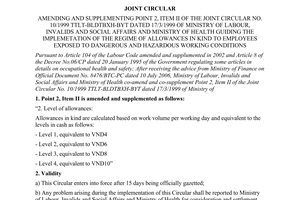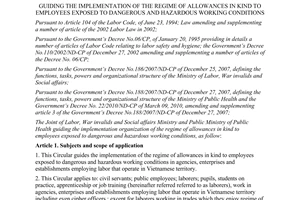Joint circular No. 10/1999/TTLT/BLDTBXH-BYT of March 17, 1999, guiding the implementation of the regime of allowances in kind for laborers working in hazardous and noxious conditions đã được thay thế bởi Joint circular No. 13/2012/TTLT-BLDTBXH-BYT guiding the implementation và được áp dụng kể từ ngày 15/07/2012.
Nội dung toàn văn Joint circular No. 10/1999/TTLT/BLDTBXH-BYT of March 17, 1999, guiding the implementation of the regime of allowances in kind for laborers working in hazardous and noxious conditions
|
THE MINISTRY OF LABOR,
WAR INVALIDS AND SOCIAL AFFAIRS - THE MINISTRY OF PUBLIC HEALTH |
SOCIALIST REPUBLIC OF VIET NAM |
|
No: 10/1999/TTLT/BLDTBXH-BYT |
Hanoi, March 17, 1999 |
JOINT CIRCULAR
GUIDING THE IMPLEMENTATION OF THE REGIME OF ALLOWANCES IN KIND FOR LABORERS WORKING IN HAZARDOUS AND NOXIOUS CONDITIONS
Pursuant to Article 104 of the Labor Code and Article 8 of Decree No.06/CP of January 20, 1995 of the Government detailing a number of articles of the Labor Code on labor safety and labor hygiene; following the recommendations of the Ministry of Finance in its Official Dispatch No.511-TC/CSTC of January 30, 1999 and of the Vietnam General Federation of Labor and related agencies, the Ministry of Labor, War Invalids and Social Affairs and the Ministry of Health jointly provide the following guidance on the implementation of the regime of allowances in kind for laborers working in hazardous and noxious conditions:
I. OBJECTS AND SCOPE OF APPLICATION
Benefiting allowances in kind are laborers including pupils and students on practice, apprenticeship or job training in the following enterprises, agencies and organizations:
- State enterprises;
- Enterprises of other economic sectors;
- Organizations and individuals employing labor to conduct production and business activities;
- Foreign-invested enterprises, enterprises in export processing zones, industrial zones and hi-tech zones;
- Foreign agencies and organizations, international organizations in Vietnam employing laborers who are Vietnamese;
- Non-business, production, business and service units belonging to administrative, non-business agencies, political and social organizations, mass organizations, the People’s Armed Forces and the People’s Public Security Forces;
- Administrative and non-business agencies;
- Agencies of political-social organizations and mass organizations;
- Foreigners working in enterprises and organizations or for individuals on Vietnamese territory all come under the scope of regulation of this Circular, except otherwise provided for in international agreements which the Socialist Republic of Vietnam has signed or acceded to.
II. CONDITIONS AND LEVELS OF ALLOWANCES
1. Conditions for allowances in kind:
Laborers working in noxious and hazardous trades and jobs listed among the specially heavy, noxious and hazardous jobs, or noxious and hazardous jobs stipulated by the State are eligible for the regime of allowances in kind if they work in the following conditions:
a/ The environment has one of the hazardous and noxious elements and fails to meet the allowed hygienic norms set by the Ministry of Health.
+ Group of physical factors: micro-climate, noise, vibration, pressure, electromagnetism, light, ionized and non-ionized radiation, laser...;
+ Group of chemical factors: noxious chemicals, noxious steams and gases, noxious dust...
b/ Direct contact with sources of infection by micro-organisms causing diseases to humans.
2. Levels of allowances:
Allowances in kind shall be made per capita and valued in money corresponding to the following levels:
Level 1, valued at 2,000 Dong;
Level 2, valued at 3,000 Dong;
Level 3, valued at 4,500 Dong;
Level 4, valued at 6,000 Dong;
III. PRINCIPLES
1. The care for the health and the prevention and fight against occupational diseases during the process of labor is the responsibility of the employer effected chiefly by technical means to improve the working conditions and strengthen labor safety equipment and labor hygiene. Because he cannot yet overcome the noxious and harmful element, the labor employer must organize allowances in kind for laborers to prevent diseases and ensure their health.
2. The organization of allowances in kind must be conducted during the work shift, ensure convenience and hygiene, must not be paid in cash and must not be included in the wage unit price.
If, due to the still unstable organization of labor, such as roving work, scattered work or work with a small labor force, it is impossible to organize collective on-site allowance, the employer must supply food in kind to the laborers who have the duty to organize themselves the food allowance as prescribed. In this case the employer must regularly inspect the implementation by the laborers and must register this allowance with the local Labor, War Invalids and Social Affairs Service.
3. Laborers who work in an environment involving hazardous and noxious elements for 50% and more of the standard time of the work day, shall enjoy the full allowance ration. If they work for 50% and less of the standard time of the work day, they shall enjoy half of the allowance ration.
In case of overtime work, the regime of allowance in kind shall increase proportionally to the overtime hours.
4. Laborers working in special trades or jobs and eligible for the regime of quantitative rations issued together with Decision No.611/TTg of September 24, 1996 of the Prime Minister shall not enjoy the levels of allowance in kind prescribed in this Circular.
5. With regard to the trades and jobs which have been agreed upon by the Ministry of Labor, War Invalids and Social Affairs as stipulated in the Joint Circular No.20/TTLB of September 24, 1992 of the Ministry of Labor, War Invalids and Social Affairs and the Ministry of Health, the following conversion shall be effected:
Former level 1 shall become level 1 in the new system;
Former level 2 shall become level 2 in the new system;
Former levels 3 and 4 shall become level 3 in the new system.
During the conversion from the former levels to the new levels, if any irrationality is detected, a written proposal should be sent to the Ministry of Labor, War Invalids and Social Affairs and the Ministry of Health for consideration and approval as stipulated in Point 2 of Section IV.
Level 4 in the new system shall apply only to trades and jobs in which the working environment involves particularly noxious or hazardous elements.
6. The expenses for the allowance in kind to the production and business units shall be accounted in the product cost or circulation cost. For the administrative and non-business agencies they shall be accounted in the regular expenditures. For objects that are pupils and students on practice, job training and apprenticeship, such expenditures shall be covered by the agency that manages these pupils and students.
IV. ORGANIZATION OF IMPLEMENTATION
1. Responsibility of the labor employer in the units and enterprises:
a/ To carry out education and to popularize the aim and significance of the regime of allowances in kind and to popularize the contents of this Circular and the regulations of the units on the implementation of this regime down to each laborer.
b/ Basing itself on the annual impact of the working environment on the different trades and specific jobs, the grassroots medical service shall have to help the employer of labor to determine the composition of the food used as allowances in conformity with the detoxification and body resistance such as sugar, milk, eggs, tea, fruits and cookies corresponding with the levels of allowance stipulated in Clause 2, Section II mentioned above.
c/ To dutifully organize the allowances in order to ensure that the laborers receive the allowance adequately and in conformity with the regime.
2. Responsibility of the ministries, branches and localities:
a/ To organize the guidance for the implementation of the stipulations in this Circular to each unit and enterprise under their managerial responsibility.
b/ On the basis of the written proposal of the units and enterprises under their management and the results of the annual measurements in the evaluation of the hazardous and noxious elements at the working place by the medical service, the summing up of the trades and jobs where allowances in kind should apply, they shall make a report and send it to the Ministry of Labor, War Invalids and Social Affairs and the Ministry of Health for consideration and decision according to the following instructions:
An integrated list of the trades and jobs in the branches and localities where allowances in kind should apply.
- Results of the annual measurements of the working environment involving hazardous and noxious elements at the working places of the Prophylactic Medicine Centers of the provinces and cities directly under the Central Government and the other agencies which the Ministry of Health has approved. For the trades and jobs in direct contact with the sources of infection stipulated in Clause b, Section 1, Part II, there is no need to attach the results of the measurements of the environment.
3. The Labor, War Invalids and Social Affairs Services and the Health Services shall coordinate with the Labor Federations in the localities to organize the implementation, inspection and supervision of the implementation of this Circular down to each unit and enterprise located in the localities according to their functions and competence.
4. This Circular takes effect 15 days after it is signed for issue and shall replace the Joint Circular No.20/TTLB of September 24, 1992 of the Ministry of Labor, War Invalids and Social Affairs and the Ministry of Health. All the other stipulations which are contrary to the provisions of this Circular are now annulled.
In the process of implementation, should any difficulty arise, the ministries, branches and localities would report to the Ministry of Labor, War Invalids and Social Affairs (the Labor Protection Department) and the Ministry of Public (the Prophylactic Medicine Department) for consideration and settlement.
|
THE MINISTRY OF LABOR,
WAR INVALIDS AND SOCIAL AFFAIRS |
THE MINISTRY OF PUBLIC
HEALTH |




